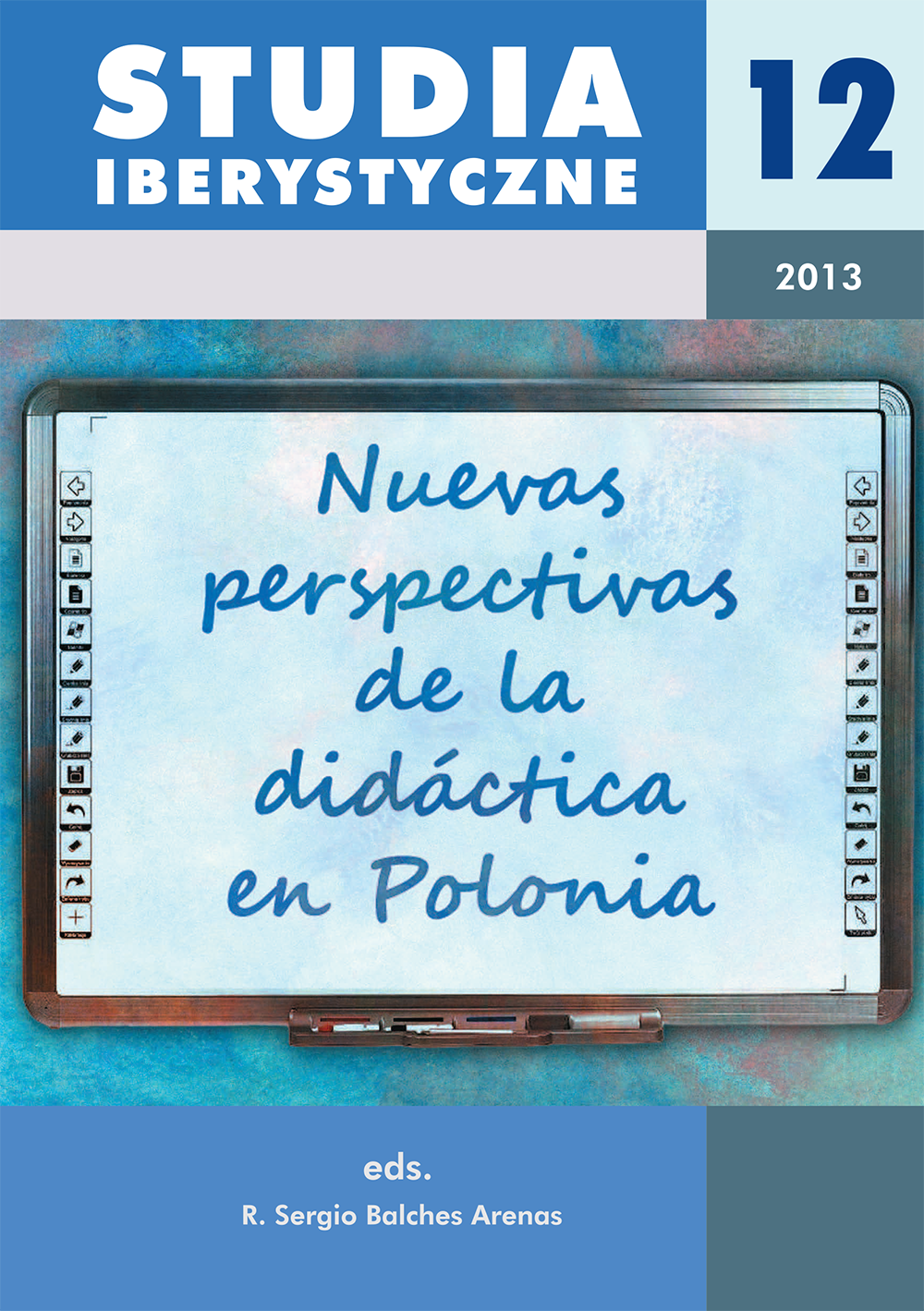Aportaciones de la Programación Neurolingüística a la enseñanza de lenguas extranjeras
DOI:
https://doi.org/10.12797/SI.12.2013.12.07Palavras-chave:
confidence in teaching, profile of a good teacher, neuro-linguistic programming, presuppositions of NLP, representational systemsResumo
NEURO-LINGUISTIC PROGRAMMING AND ITS CONTRIBUTION TO FOREIGN LANGUAGE TEACHING
In the first place, the article presents an inquiry conducted among students of foreign languages to get to know how define the teacher who inspires confidence. In second place, it describes what is the Neuro-Linguistic Programming, what are its origins and what are its theories and methodological resources most beneficial to optimize the teaching and learning of foreign languages and to approach the profile of a perfect decent.
Referências
ALDER, H., HEATHER B. (2012), NLP w 21 dni, tłum. A. Sawicka-Chrapkowicz, Dom Wydawniczy Rebis, Poznań.
ALFÉREZ VILLARREAL, A. (2011), “Programación neurolingúística en la comunicación oral de los docentes de educación superior. Creación de un cuadro de observación”, [on-line] http://www.cite2011.com/Comunicaciones/Neurociencia/121.pdf – 20.07.2013.
BANDLER, R. (2011), Use su cabeza para variar. Submodalidades en Programación neurolingüística, Editorial Cuatro Vientos, Santiago de Chile.
BANDLER, R., FITZPATRICK, O. (2008), Conversaciones. La Libertad Es Todo y El Amor Todo Lo Demás, Editorial Khaos, México.
BANDLER, R., GRINDER, J. (2006), De sapos a príncipes. Transcripción del seminario de los creadores de la PNL, Gaia Ediciones, Madrid.
BAVISTER, S., VICKERS, A. (2010), NLP w praktyce czyli sztuka kształtowania przyszłości, tłum. K. Zimoch, Editorial Edgard, Warszawa.
BAVISTER, S., VICKERS, A. (2011), Programación neurolingüística (PNL): Las claves para una comunicación más efectiva, Amat Editorial, Barcelona.
CARRIÓN LÓPEZ, S.A., MARTÍNEZ ALCÁZAR, M. (2009), Enseñando a enseñar con PNL. Trainer’s Training, PNL Books Ediciones, Spain.
CHURCHES, R., TERRY, R. (2010), NLP dla nauczycieli. Szkoła efektywnego nauczania, tłum. B. Solecki, Helion S.A., Gliwice.
CZESŁAWIAK, A. (2005a), “Neurolingwistyczne programowanie w edukacji”, [on-line] http://www.skp2.sokp.pl/publik.htm – 23.07.2013.
CZESŁAWIAK, A. (2005b), “Neurolingwistyczne programowanie w edukacji, cz. II: Elementy języka wpływu w rzeczywistości szkolnej”, [on-line] http://www.skp2.sokp.pl/publik.htm – 23.07.2013.
CZESŁAWIAK, A. (2005c), “Poznawanie ucznia a praca wychowawcza nauczyciela”, [on-line] http://www.skp2.sokp.pl/publik.htm – 23.07.2013.
DILTS, R., EPSTEIN, T. (2011), Aprendizaje Dinámico con PNL, Ediciones Urano, Barcelona.
FELDER, L. (2012), Writing for the Web. Creating Compelling Web Content Using Words, Pictures and Sound, New Riders, Berkeley.
GRZYBEK, H., “Neurolingwistyczne programowanie w edukacji”, [on-line] http://www.gmsolutions.pl/pdf/Alma%20Mater%20NLP%20w%20edukacji.pdf – 22.07.2013.
LÓPEZ, M.I., LÓPEZ, G.E. (2008), “Los sistemas representativos en el aula”, Actas de X Congreso Nacional y II Congreso Internacional “Representar la niñez en el siglo XXI”, Mendoza, [on-line] http://www.feeye.uncu.edu.ar/web/X-CN-REDUEI/eje3/Lopez.pdf – 22.07.2013.
O’CONNOR, J., SEYMOUR, J. (2012), Introducción a la Programación neurolingüística, Ediciones Urano, Barcelona.
ROCHA BERNABÉ, M., ARZATE GORDILLO, J., CRUZ HERNÁNDEZ, H. (2008), “Experiencia didáctica con el apoyo de las TIC para el desarrollo de habilidades en asignaturas tecnicas”, [on-line] http://www.repositoriodigital.ipn.mx/bitstream/handle/123456789/3603/23.pdf?sequence=1 – 23.07.2013.
RODRÍGUEZ TORRES, S. (1997), “La Programación Neurolingüística como fuente de recursos para el profesor de lenguas extranjeras”, Actas de ASELE del VII Congreso Internacional. La Enseñanza del Español como Lengua Extranjera: del Pasado al Futuro, Alcalá de Henares, pp. 699-704. [on-line] http://cvc.cervantes.es/ensenanza/biblioteca_ele/asele/pdf/08/08_0697.pdf – 20.07.2013.
SOUSA, S., LAMAS, D., HUDSON, B. (2006), “Understanding Learners’ Trust within an Online Distance Learning Context”, [on-line] http://www.academia.edu/2742329/Understanding_learners_trust_within_an_online_distance_learning_context – 22.07.2013.
STEFANIAK, M. (2005), “Widzę, słyszę, czuję, czyli programowanie neurolingwistyczne w przedszkolu”, [on-line] http://www.ckp.edu.pl/main/zasoby/zeszyty/2/Widze%20slysze%20czuje.pdf – 23.07.2013.
VACCARINI, V., „La comunicación en el aula: estrategias para mejorar el aprendizaje y fortalecer el vínculo alumno-docente”, [on-line] http://www.vilmavaccarini.com.ar/docs/comunicacionenaula.pdf – 23.07.2013.
VELLEGAL, A.M. (2004), La Programación Neurolingüística como herramienta para la enseñanza de E/LE, Memoria Máster en Enseñanza de Español Lengua Extranjera, Enero de 2004, [on-line] http://www.educacion.gob.es/dctm/redele/MaterialRedEle/Biblioteca/2005_BV_03/2005_BV_03_18Vellegal.pdf?documentId=0901e72b80e4023b – 22.07.2013.
ZIEMKOWSKA, J. (2007), “Wybrane zagadnienia optymalizujące przebieg procesu dydaktycznego w kontekście programowania neurolingwistycznego”, [on-line] http://spnjo.polsl.pl/konferencja/materialy/referaty/ziemkowska.pdf – 23.07.2013.
Downloads
Publicado
Edição
Secção
Licença
Direitos de Autor (c) 2013 Aneta Pawlak

Este trabalho encontra-se publicado com a Licença Internacional Creative Commons Atribuição-NãoComercial-SemDerivações 4.0.






